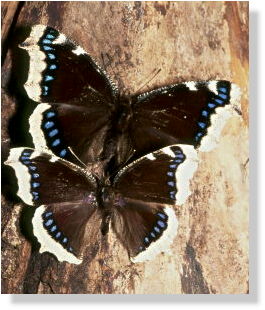 |
Whereas most butterflies hibernate in the form of their caterpillar or of their chrysalis, few get through the winter as butterflies. Amongst them is the Camberwell Beauty (Nymphalis antiopa). It is a rather rare species. Because they do not need to mature into a pupae and to hatch, but can just fly off from their hide, they belong to the species very early to be seen in spring. In spring, the hibernating Camberwell Beauties have had quite a long lifetime (or lifespan?). Many of their scales have worn off and their colours have gotten weaker. Still: the Beauty remains a beauty, at least from the butterflies' point of view. Each spring, their call and mating takes place with passion. In the picture on the left the female is in front. The male approaches from behind, keeping his antennae in touch with her wings. Scents released by the female also play a part in their communication, the male receiving them via his antennae. |
